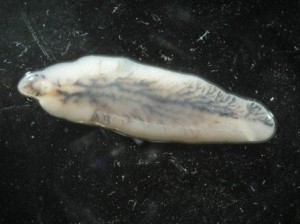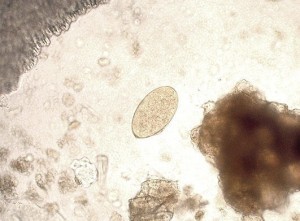Fascioliasis (Liver Fluke Worm Disease) Symptoms, Treatment
There are many types of parasitic worms that can infest the human body. Most of us know about worms that live in the gut and feed off nutrients in the food we eat. But there are parasitic worms that can even live within the organs in the body or bloodstream. Flatworms are one category of parasitic worms that live in the body. It is also known by the common term ‘flukes’. There are many different types which can infect humans and reside at a variety of sites within the body.
What is a liver fluke?
Liver flukes are a type of parasitic worm (helminth) that lives in the liver. Flukes are the term for a type of parasitic worm known as trematodes (flatworms). There are many different types of flukes and the liver fluke is just one type. Furthermore there are several different species of liver flukes. The species that most commonly affects humans is Fasciola hepatica. It is also known as the sheep liver fluke but also infects cattle. Another species that can also infect humans is Fasciola gigantica. For this reason, liver fluke infection with these species is known as fascioliasis.
The Fasciola hepatica fluke is among the largest of the flatworms. It reaches a length of about 30mm (just over 1 inch). Infection in humans does not only occur among meat eaters. The larvae can attach to freshwater vegetables and herbs and then enter the body when these plants are consumed raw. The worm cannot be spread from one person to another. The symptoms of fascioliasis are usually mild and non-specific but it can cause serious disease in some people. It is also possible for the worm to migrate to sites outside of the liver like the skin, heart, lungs and brain although this is not common.
Picture of Fasciola hepatic liver fluke
How common is it?
Overall a liver fluke infection is rare in the United States. Most cases in the US are seen among immigrants who come from endemic regions. Fasciola hepatica is found throughout the world except Antarctica while Fasciola gigantica is isolated to some tropical regions. However, most cases of fascioliasis are found to occur in developing nations and parts of Western Europe. Males have a slightly higher risk of being infected. The prevalence varies but in countries like Bolivia the rate is higher than 65%. The infection does not have a predilection for race or age, although the majority of people that are infected are adults.
Spread of Liver Fluke to Humans
Fasciola hepatica and Fasciola gigantica infect both sheep and cattle. However, these animals are not required for the parasite to be transmitted to humans. In fact people are infected accidentally through consuming certain raw freshwater plants. A type of fascioliasis can however be acquired through eating the raw livers of sheep, goat or cattle. Since this practice is rare, the main mode of transmission is through consuming plants like watercress, water lettuce, mint and parsley.
Life Cyle
It is important to understand the life cycle of the liver fluke when looking at the spread of these worms.
- Worm eggs in animal stool makes contact with water.
- Miracidia (larvae) hatch within 9 to 14 days if the water is tepid to warm.
- These larvae then enter freshwater snails.
- It matures and exist as another type of larvae known as cercaria.
- These free-swimming larvae the attach to freshwater plants.
- The larvae become enclosed in a cyst (encyst).
- Once consumed by humans, it emerges from this cyst (excyst) when it reaches the duodenum (small intestine).
- The larvae then penetrate the bowel wall and eventually reaches the liver.
- Over a period of 3 to 4 months the larvae move through the liver and mature.
- It finally lodges in the hepatic and common bile ducts. Sometimes in can lodge in the gallbladder.
- About 4 to 6 months later the adult fluke worms produce eggs which then pass out into the intestine.
Adult fluke worms can live for years within the hepatic and common bile ducts. It survives by feeding on the host liver cells (hepatocytes) and epithelium of the duct wall. It can produce tens of thousands of eggs in its lifetime.
Signs and Symptoms
Fascioliasis presents with non-specific symptoms that are usually mild. In half of all cases these symptoms are not clearly indicative of fascioliasis. Most chronic infections are asymptomatic, meaning that there are no symptoms present. The infection is diagnosed by the presence of eggs (ova) in the stool. Blood tests are not conclusive for this specific infection. Imaging studies like an abdominal ultrasound and CT scan may reveal the burrow tracks of the worms in the liver tissue.
Picture of Fasciola hepatica eggs
The signs and symptoms of fascioliasis include:
- Right upper quadrant abdominal pain.
- Fever (intermittent).
- Enlargement of the liver (hepatomegaly) which may be tender or non-tender.
- Malaise (a general feeling of being unwell).
- Unexplained weight loss.
- Paleness of the skin (pallor).
Hives (urticaria) has also been observed in about 20% of cases. Other symptoms like dizziness and sweating may also occur with fascioliasis although this is mainly seen in children. Nodules under the skin (subcutaneous) and wheezing may occur when the worms are lodged in other organs.
- Severe sore throat and swelling of the voice box may be seen in people who contract the infection by eating raw liver of infected animals.
- Severe abdominal pain with persistent fever and jaundice may occur in people who develop cholangitis (bile duct infection) as a complication.
- Intense symptoms like severe abdominal pain, fever, nausea and vomiting may occur in people who develop pancreatitis as a complication. This mainly occurs in children.
Prevention and Treatment
Liver fluke infection can be easily prevented and effectively treated. People living in endemic regions need to be informed against risky behavior and about the symptoms for early diagnosis. Although the infection cannot be transmitted from one person to another, it is likely to occur in families since members are consuming the same contaminated food.
How to prevent liver flukes?
- Avoid eating raw liver from sheep, goats and cattle.
- Ensure that water used for drinking and preparing food is clean.
- Do not eat raw ground fruit and vegetables grown near grazing pastures.
- Cook fresh water plants like watercress before eating.
- Fresh water plants that are being eaten raw should be soaked in a 6% acetic acid solution for 5 to 10 minutes.
How to eradicate liver flukes?
- Triclabendazole is the drug of choice for treating liver flukes.
- Corticosteroids (short course) may be prescribed for acute phases with severe symptoms.
- Surgery may be necessary for complications like cholangitis.
References:







